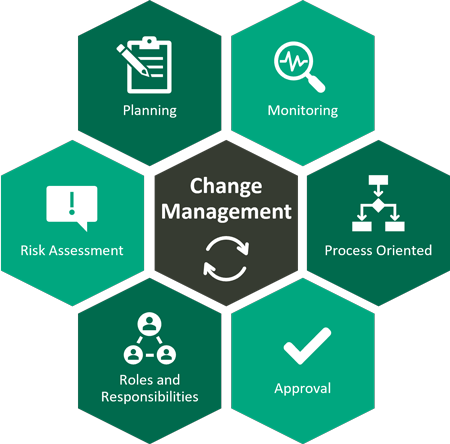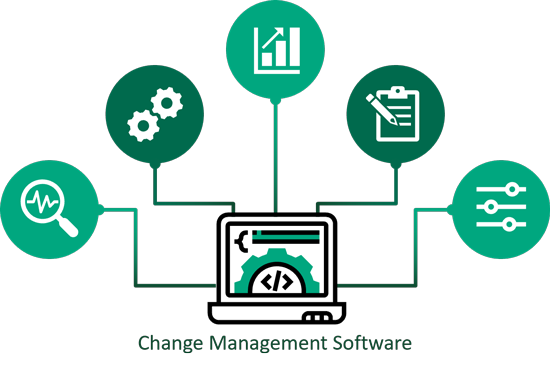Introduction to ITIL Change Management
ITIL Change Management is an IT Service Management (ITSM) methodology that helps organizations effectively manage changes to IT services, processes and systems and improve service quality for users and supporters.
The process is intended to ensure that standardized methods and procedures (hence ITIL Change Management) for implementing changes are established and effectively implemented. In this way, the process prevents unnecessary disruptions and acts as assistance in the case of failures. The goal here is to reduce external and internal risks triggered by change.
The implementation of change management according to ITIL subsequently increases the effectiveness and profitability of your own company.
What is ITIL Change Management?
There are several perspectives on change management. From a business perspective, from a risk perspective, in terms of dependencies, and from a competitiveness perspective.
Change management according to ITIL is a crucial process that focuses on planning, monitoring and implementing changes to IT services, processes and systems. The goal is always to reduce the risk of errors and disruptions to a minimum and thus ensure the quality and stability of IT services.
What is a Change?
Basically, “change” means a change for an organization, which is also associated with risk. According to ITIL, the term Change refers to any change that is made to
- IT services, systems, processes or
- other components in the infrastructure area.
These may be changes to hardware, software or the IT infrastructure in general. ITIL V4 classifies 3 groups of changes:
The ITIL definition of change is therefore broad and encompasses all changes to IT services, systems or processes that are critical for the company. In addition, modifications in organizational procedures or processes can also be referred to as change. This means that changes are not only change processes, but also adjustments to software or approaches in a company.
The goals: Why is Change Management important?
Change management is important because it helps to minimize the risk of errors and disruptions in IT services and thus ensure the quality of services. Without change management processes, unforeseeable effects on the IT environment can occur and have a negative impact on users, supporters and employees.
Here is an example: When a company decides to introduce a new version of its software, it issues instructions to install the update. However, the IT department ignores the change management process and installs the software directly on production systems without checking or approving the process.
After the installation, serious compatibility issues occur as a consequence, causing system failures and blocking access to business-critical applications. The downtime creates conflicts with users unable to perform their work and the support department tasked with restoring services.
Ultimately, the company has to use additional resources to rectify the problem, which leads to considerable costs and business interruptions. If the company had implemented change management processes and carefully planned and evaluated the change, the negative impact of the change on the IT environment and business operations would have been avoided – which is exactly why change management is so important.
Differences between Change Management and other ITSM processes
Change Management, Incident Management, Release Management, Capacity Management, and Problem Management are all directly related, but do not mean the same thing. It is therefore important to consider each area individually:
- The main task of incident management is to resolve incidents at short notice.
- Problem management looks for permanent solutions and analyzes the problems behind incidents.
- Change management deals with the implementation of changes that may arise as a result of identified problems.
- Capacity management, on the other hand, must assess the impact of changes on existing capacities and identify additional capacities required. Additional capacity requirements must be included in the capacity plan and as such must also be treated as Requests for a Change (RfCs).
- Release management is the process responsible for planning the timing and controlling the transition of releases to test and live environments.
What are the benefits of ITIL Change Management?
Basically, the benefits of good change management can be broken down into the following five:
Simply stating the benefits is helpful, but in the end it always comes down to whether an investment pays off for a company. This is where the cost-benefit analysis comes into play: the aim of a cost-benefit analysis for change management is to demonstrate the relationship between the costs of administration or implementation and the benefits that result from the approach:
Once you understand the benefits and advantages of change management, you need to know what roles, processes and information are relevant.
In order to understand change processes, you need to know how they are put together and which components are important. For this, we need to clarify two terms in the first step, namely Configuration Item (CI) and Configuration Management Database (CMDB).
In order to assess the risk of changes, you need detailed information about the individual configuration items (CI) and their relations to each other. A CI is a part of the entirety of operating resources in a company and can include PCs, peripheral devices, telephones, all network components, servers, installation documentation, process instructions, IT services and also software – in other words, all components that can trigger a change due to a malfunction.
Configuration Management captures and manages these components in a Configuration Management Database (CMDB). This means that changes can be controlled and, if possible, even automated, as all important components and their relationship to each other are collected and configured in a database.
Typically, change management covers the entire process from the initialization of the change (the so-called change request) to the review of the change after implementation. The focus is always on ensuring that all changes to the IT infrastructure are subject to a controlled assessment, approval, implementation and review process.
This requires going through several steps in the change management process.
Tasks and Responsibilities in Change Management
There are also different roles and responsibilities in change management. Each role has specific responsibilities and functions. To ensure that changes are carefully planned, documented and tested, and that the risk of disruptions and failures remains minimal, all roles must work together intelligently. To do this, companies use a change advisory board.
Now about the specific roles:
In addition, there is also the role of the change owner, the change advisory board, the change authority, the change requester (CR), the change tester, the change implementer and the change developer (builder).
Change-Advisory-Board (CAB)
This is not a role, but rather a combination of important roles in change management. Some understand the term “board” to mean very formal regular meetings of the same group of top managers.
The CAB supports the change manager in assessing and prioritizing changes in terms of business impact. When a CAB is convened, the members selected must be capable of evaluating the Change from both a business and technical standpoint.
Software for Change Management
The majority of all companies today are heavily dependent on IT systems and IT technology. It is therefore essential that sufficient time is invested in good change management within the company. This is because the assessment of risks and dependencies as well as the business criticality of changes and decisions is a holistic task.
Change management has now become a full-time task: In this way, the process of changes should be effectively controlled and optimized in order to minimize risks and possible disruptions. The key factor here is choosing the right software.
As technologies evolve, markets change and companies grow, so must the IT infrastructure. This is precisely the point at which change management should come into play, ideally hand in hand with a suitable software solution.
What is Change Management Software?
A change management software is an IT tool that helps within IT service management to…
- automate,
- document,
- manage and
- to control.
The software mostly offers functions for managing the entire change management process, including the management of requests for changes, the documentation up to the release of changes, the execution of tests and reviews and the creation of reports and analyses.
How can software improve Change Management?
Change management software automates and simplifies the process of change and minimizes the risks and impact of unforeseen problems. It also helps monitor compliance with ITIL standard processes, improves efficiency and helps control costs and schedules by keeping all parties involved on the same level of knowledge and facilitating collaboration.
What are the features and functions of a good Change Management Software?
In order to implement a successful change in IT service management, a thorough analysis of the current status and a definition of the desired future status is required. You can prevent problems by scheduling a testing period before implementing the changes.
A service management tool can help unify ITSM processes and improve process control. Among other things, the tool should enable:
The software The software should also provide transparency about dependencies and possible effects in the IT infrastructure as well as about all change and release management activities (from the initial request to the post-implementation review). All change and release management activities should be comprehensively processed and documented in a change management software.
Emergency Change Advisory Board (ECAB) risk assessment should also be improved through comprehensive and transparent risk management. IT management software that meets these requirements helps to simplify the ITIL change management workflow and improve the effectiveness of change management processes.
How to choose a suitable software for change management?
The selection process of a suitable software for change management should consider the following steps:
It is also important that the tool fits the company’s individual needs and that solid documentation, training and support are provided. It should also be flexible and scalable so that it can meet the company’s changing requirements in the future.
Success with ITIL Change Management
Change management is not just a process that focuses on the IT infrastructure – it affects the entire organization. Through clear goals, ITSM tools, and employee engagement, organizations can ensure they effectively and successfully implement change to respond to an ever-changing business environment.
ITIL Change Management is an essential component in optimizing processes and increasing the long-term success of organizations. Therefore, work with an experienced partner like REALTECH when implementing incident, problem, and change management. Our SmartITSM solution combines all the advantages. Feel free to make a free appointment or request our free demo.



